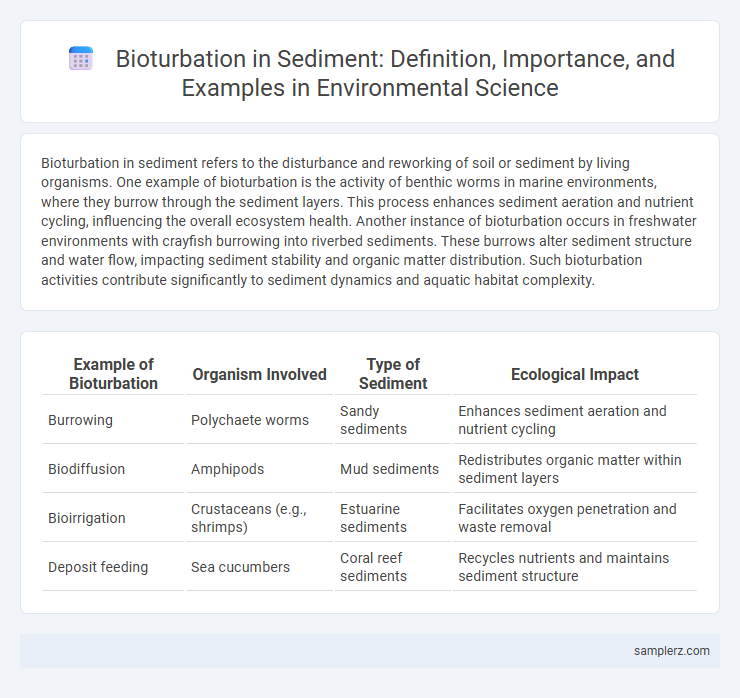Bioturbation in sediment refers to the disturbance and reworking of soil or sediment by living organisms. One example of bioturbation is the activity of benthic worms in marine environments, where they burrow through the sediment layers. This process enhances sediment aeration and nutrient cycling, influencing the overall ecosystem health. Another instance of bioturbation occurs in freshwater environments with crayfish burrowing into riverbed sediments. These burrows alter sediment structure and water flow, impacting sediment stability and organic matter distribution. Such bioturbation activities contribute significantly to sediment dynamics and aquatic habitat complexity.
Table of Comparison
| Example of Bioturbation | Organism Involved | Type of Sediment | Ecological Impact |
|---|---|---|---|
| Burrowing | Polychaete worms | Sandy sediments | Enhances sediment aeration and nutrient cycling |
| Biodiffusion | Amphipods | Mud sediments | Redistributes organic matter within sediment layers |
| Bioirrigation | Crustaceans (e.g., shrimps) | Estuarine sediments | Facilitates oxygen penetration and waste removal |
| Deposit feeding | Sea cucumbers | Coral reef sediments | Recycles nutrients and maintains sediment structure |
Overview of Bioturbation in Sediment
Bioturbation in sediment refers to the reworking of soils and sediments by animals or plants, significantly influencing sediment structure and nutrient cycling. Common examples include burrowing activities of worms, crustaceans, and bivalves that aerate sediments, enhance microbial activity, and facilitate organic matter decomposition. This ecological process plays a crucial role in maintaining habitat quality and promoting sediment stability in aquatic ecosystems.
Key Organisms Responsible for Bioturbation
Bioturbation in sediment is primarily driven by key organisms such as polychaete worms, burrowing crustaceans, and bivalves, which rework the sediment layers through their digging and feeding activities. These organisms enhance oxygen penetration and nutrient cycling by disturbing sediment stratification and facilitating organic matter decomposition. Their combined actions significantly influence sediment structure, microbial communities, and overall ecosystem functioning in aquatic environments.
Bioturbation by Polychaete Worms
Polychaete worms significantly contribute to bioturbation by burrowing and mixing sediments, enhancing oxygen penetration and nutrient recycling in marine ecosystems. Their continuous movement redistributes organic matter and sediment particles, promoting microbial activity and improving sediment structure. This process supports benthic biodiversity and maintains healthy sedimentary environments.
Crustaceans' Role in Sediment Mixing
Crustaceans such as crabs, shrimp, and amphipods play a crucial role in bioturbation by burrowing and disturbing sediment layers, enhancing oxygen penetration and nutrient cycling. Their activities facilitate the breakdown of organic matter and promote habitat heterogeneity, which supports diverse microbial communities and benthic fauna. This sediment mixing by crustaceans significantly influences sediment structure and ecosystem productivity in aquatic environments.
Mollusks as Agents of Bioturbation
Mollusks such as clams, mussels, and burrowing snails actively rework sediment layers through their burrowing and feeding activities, significantly influencing sediment texture and aeration. Their bioturbation enhances nutrient cycling and promotes oxygen penetration into anoxic sediment zones, supporting diverse microbial communities. This sediment disturbance by mollusks plays a critical role in maintaining ecosystem productivity and sediment stability in aquatic environments.
Burrowing Behavior of Echinoderms
Burrowing behavior of echinoderms, such as sea urchins and heart urchins, plays a crucial role in bioturbation by reworking sediment layers and enhancing nutrient cycling in marine ecosystems. Their movement through sediment disturbs the substrate, increasing oxygen penetration and promoting microbial activity that supports benthic food webs. This natural sediment mixing improves habitat complexity and influences sediment chemistry, contributing significantly to the health of coastal and deep-sea environments.
Impacts of Fish Activity on Sediment Structure
Fish activity significantly influences sediment structure through bioturbation, which enhances sediment permeability and oxygenation by redistributing particles. This process facilitates nutrient cycling and supports microbial communities, promoting overall ecosystem productivity. Species such as gobies and catfish are notable bioturbators, actively disturbing sediment layers during their feeding and nesting behaviors.
Microbial Contributions to Bioturbation
Microbial contributions to bioturbation play a critical role in sediment dynamics by facilitating the breakdown and redistribution of organic matter through metabolic activities. Microorganisms such as bacteria and archaea produce extracellular enzymes that degrade complex polymers, enhancing nutrient cycling within sediment layers. This microbial-driven bioturbation influences sediment oxygenation, biogeochemical gradients, and supports benthic ecosystem productivity.
Effects of Bioturbation on Nutrient Cycling
Bioturbation by benthic organisms such as worms, clams, and crustaceans significantly enhances nutrient cycling in sediment by increasing oxygen penetration and facilitating the redistribution of organic matter. This process accelerates the decomposition of organic materials, releasing nutrients like nitrogen and phosphorus into the pore water, which promotes primary productivity in aquatic ecosystems. Furthermore, bioturbation alters sediment structure, improving microbial activity and enhancing denitrification, thus contributing to the regulation of nutrient fluxes and overall ecosystem health.
Environmental Significance of Sediment Bioturbation
Bioturbation in sediment, such as the burrowing activities of polychaete worms and bivalves, plays a crucial role in enhancing sediment oxygenation and nutrient cycling. These biological processes increase sediment porosity and facilitate organic matter decomposition, promoting ecosystem productivity and habitat quality. Sediment bioturbation significantly influences contaminant degradation, mitigating pollution in aquatic environments.

example of bioturbation in sediment Infographic
 samplerz.com
samplerz.com